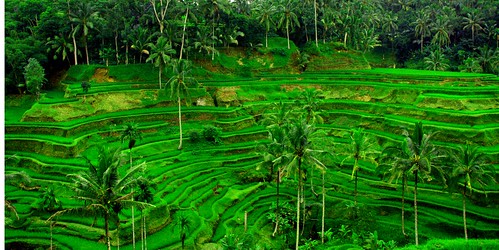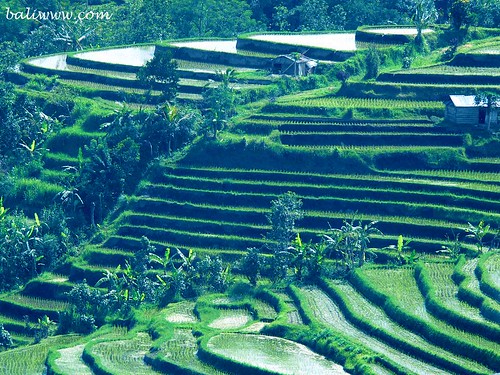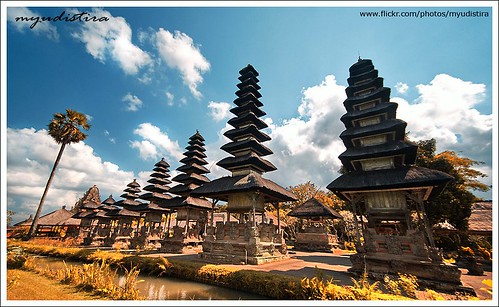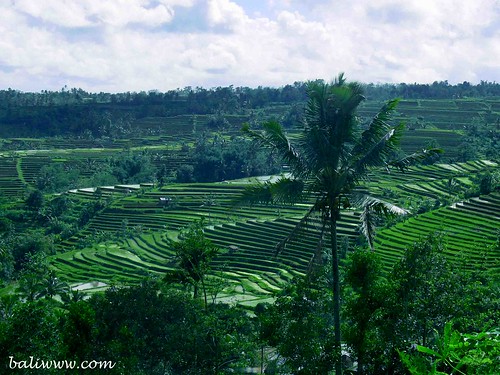Here is a write up on Bali’s cultural landscape prepared by Directorate General of History and Archaeology of Bali, that is submitted to UNESCO in accordance with World Heritage Program. I hope this writing can give a better view on Bali’s cultural landscape.
Cultural Landscape of Bali Province
Description
The island of Bali has long been characterized in the world as the last “paradise” on earth, a traditional society insulated from the modern world and its vicissitudes, whose inhabitants have exceptional artistic talents and consecrate a considerable amount of time and wealth to sumptuous ceremonies for their own pleasure and that of their gods. Therefore, the relation between the tangible and intangible aspects is a major aspect of the heritage and culture of Bali. The cultural heritage of the island goes way beyond physical structures and landscapes. More than anywhere else on the Indonesian peninsula an intricate connection exists between the built environment, the natural settings and the social and religious life.
Bali is a part of the Indonesian archipelago, lying between eight and nine degrees south of the equator. It covers an area of 563.300 hectares including three offshore islands.
The combination of tropical climate, rain and fertile volcanic soil makes Bali an ideal place for crop cultivation; including the growing of rice, coconut, cloves and coffee. These agricultural activities have had a great influence on the Bali landscape, notably in the creation of rice terraces. Over the last thousand years, the people of Bali have extensively modified the landscape of their island, terracing hillsides and digging canals to irrigate the land, enabling them to grow rice.
Rivers run all over Bali and this continuous flow of water sustains the agricultural activity. An elaborate irrigation system has been created to take maximum benefit of the water. In honour of the water, which allows the agricultural activities, the Balinese make offerings at the springs. This irrigation system has also made possible the coordination of cooperatives known as subak. They are a kind of democratic organization in which the farmers whose fields are fed by the same water source, meet regularly to coordinate plantings, to control the distribution of irrigation water and to plan the construction and maintenance of canals and dams, as well as to organize ritual offerings and subak temple festivals.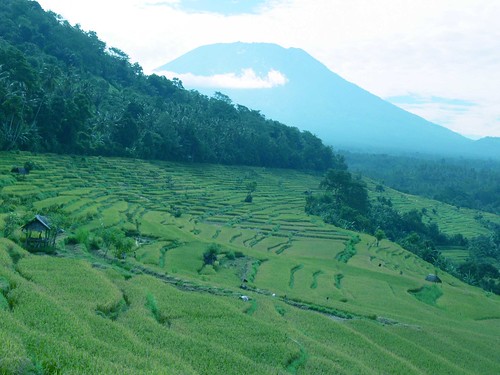
Rice is the main food component on Bali and the Balinese people believe that rice is a gift of the gods. The first fruits are given back to the gods and complex ceremonies accompany each stage of the growth of the rice plant.
Together with these natural elements, the Hindu religion dominates everyday life on Bali. The Hindu cosmology exists on three levels: the gods above the mountain peaks, the demons below the earth and sea, and the human world in between. The temples are the meeting places between humans and gods. Many rituals seek to maintain this harmony, which also exists in the micro cosmos – the mountains, the sea and the land – and which is visualized everywhere in the layout of villages, homes, and temples and even in the human body. This philosophy of the universe-Tri Hita Karana governs the landscaping of temples and the surrounding environment.
The Balinese village is a tight network of social, religious and economic institutions, of which each person on the island is a part. The Banjar, or village association is an ingenious form of local government unique to Bali. These cooperative associations of neighbours govern daily life in great detail according to local law.
Three cluster sites were proposed for World Heritage inscription with possible extension of Pura Besakih Temple compound subject to socialization process:
- Jatiluwih Rice Field Terraces, traditional villages in the Tabanan region together with its surrounding rice terraces;
- Taman Ayun, the islands’ main temple complex;
- a group of eight (8) temples along the Pakerisan river valley; and
- Pura Besakih temple compound for possible extension.
The cluster sites as an ensemble represent the Bali Cultural Landscape of international significance.
The Jatiluwih Rice Field Terraces explain the distinctive feature of the social and engineering system of Subak, which interrelates with the Balinese philosophy of Tri Hita Karana.
Taman Ayun Temple compound is an important representative of ongoing traditions in religion, temple construction, ceremonial activities and social cohesion.
The group of temple complexes, archaeological sites and landscape along the Pakerisan River, reveals historic development of religious and architectural concepts which are clear testimony of the Hindu-Balinese cosmology concept of Tri Hita Karana, the God, human being and natural environment interlinked with each other.
Justification for Outstanding Universal Value
Satements of authenticity and/or integrity
The Cultural Landscape of Bali Province is an outstanding manifestation of unique Balinese cosmological doctrine. It is tangible reflection of the original Balinese ideas and beliefs which roots essentially in Tri Hita Karana concept, that is the awareness of the need to always maintain the harmonious relationship between God, Human, and Nature in daily life. Such a particular concept is in fact evidence of Balinese creative genius and unique cultural tradition as a result of a long human interaction, especially between the Balinese and Indian. All the cluster sites of the Cultural Landscape also directly demonstrates the capability of Balinese to make their unique cosmological doctrines real and practiced in their daily life through spatial planning and land use (cultural landscape), settlement arrangement, architecture, ceremonies and rituals, art, and social organization. Indeed the implementation of the concept has evidently generated a beautiful cultural landscape. All those achievements deserve to be appreciated as an outstanding universal value.
Comparison with other similar properties
The cultural landscape of Bali Province is a unique entity which materializes the unique Balinese philosophy, Tri Hita Karana. In essence, this philosophy affirms that happiness, prosperity, and peacefulness could only be attained if the God, humans, and nature live in harmony with each others.
This philosophy governs is an outstanding example of harmonious relation between supernatural (God), human, and nature. The temples that characterized the landscape and ceremonies conducted there manifest the Balinese eagerness to seek harmonious relation with God. The socio-religious organizations that responsible for maintaining the landscape, including Subak irrigation organization, are vehicle for keeping a good relationship among humankind. Meanwhile, how the Balinese build the landscape, such as choosing their temple locations and designs, build irrigation facilities, and make their rice field terraces, demonstrate their commitment to keep harmonious relationship with their environment. The harmonic arrangement of natural landscape and built environment illustrate the ingenious adaptation to a small island with still active volcanoes and rugged topographic environment.
A thorough research has been carried out to seek for possible comparatives for Cultural Landscape of Bali Province. Within the Indonesian archipelago, it is hardly found a comparable cultural landscape. Although some rice-field terraces exist in Sumatera and Sulawesi, there is no elaborate irrigation organization comparable to Subak in Bali. The rice-field terrace of Sumatra and Sulawesi have no specific temples or rituals which characterize the Cultural Landscape of Bali Province. Furthermore, the formation of rice-field terraces of Sumatra and Sulawesi is of more technical consideration while in Bali the landscape is created as a manifestation of Tri Hita Karana philosophy.
Outside Indonesia, the rice terraces of the Philippines Cordilleras in Luzon, the Philippines, may be compared to rice-field terraces of Subak Jatiluwih in Tabanan. The former was established around 2000 years ago and fed by an ancient irrigation system. The water flows from the rainforests above the Ifugao Mountains. In 1995, the Banaue rice terrace was declared as a World Heritage Site. As in Jatiluwih, the Banaue irrigation system is supported by traditional organization, agricultural engineering, ritual and belief system. However, the ritual and belief systems as well as the organization behind the system are quite different. Ifugao ritual and belief system has no Hindu influence at all, while Balinese ritual and belief system has been considerably influenced by Hinduism. This is evident in the occurrence of small temples in Jatiluwih rice terrace which are dedicated to Sri, the goddess of rice. Furthermore, the structure of Jatiluwih irrigation system (subak) has its root in the Tri Hita Karana, the essence of Balinese cosmology. Therefore, Jatiluwih rice terrace is unique phenomenon which are quite different to that of Ifugao or other rice-terrace system in world.
Regarding the rock-cut temples along Pakerisan and Patanu Rivers, Bernet-Kempers (1977) suggests its resemblance to Ajanta dan Ellora cave temples found near Aurangabad, Deccan (India). However, it should be emphasized here that the philosophy behind the rock-cut temples in India and those of Bali is totally different. Unlike in India, a Balinese temple is likely a megalithic ritual place and dedicated to a certain divine king or prominent figures rather than certain gods (Ramseyer, 2002). What is more, all the temples included in the Cultural Landscape of Bali Province are always related to water which is regarded as the most important substance as a means to maintain a harmonious relationship between God, humans, and environment (Tri Hita Karana). Such a philosophy does not exist in the Indian rock- cut temples.



